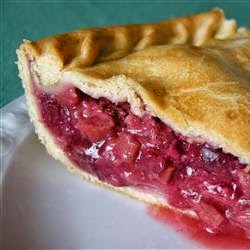Rhubarb:
Rhubarb is a herbaceous perennial growing from short thick rhizomes. It has large leaves that are somewhat triangular with long fleshy petioles (leaf stalks). In culinary use the fresh stalks are crisp with a strong tart taste. The plant stalks are cooked in sugar and used in pies and other desserts.Washington is the leading rhubarb producer in the U.S.. Oregon, Michigan, and California are also rhubarb producers. There are two types of rhubarb: hothouse rhubarb and field rhubarb. Hothouse rhubarb, sometimes called strawberry rhubarb due to its pinkish hue, is general smaller and less stringy than field rhubarb. It is also less coarsely textured and sweeter. Fiels grown rhubarb has a more pronounced tart rhubarb flavor. The stalks are darker red and thus this is called cherry rhubarb.
Rhubarb is usually considered a vegetable, but we most often use it as a fruit. In 1947 a New York court ruled that since it was used as a fruit in the U.S. , rhubarb was counted as a fruit for purposes of regulations and duties thereby lowering tariffs on imported rhubarb.
Rhubarab contains glycosides, especially glucoheins and emodin which impart cathartic and laxative properties. In traditional Chinese medicine rhubarb roots have been used as a laxative for several thousand years. Rhubarb is 95% water and contains a fair amount of potassium. It is rich in vitamin C, dietary fiber, and calcium.
Rhubarb leaves contain poisonous substances, including oxalic acid, which is a nephrotoxic and corrosive acid. It is important to cut all of the leave away from the stalk before using.
Hot house rhubarb is available from Januaray through April and field rhubarb begins in March and runs through August into early fall. The peak period is April and May. Choose firm crisp stalks with no spots or dark patches. Today rhubarb is usually sold with the leaves already cut off. Avoid rhubarb that has wilted leaves or flabby stalks. After removing any leaves store rhubarb unwashed in the refrigerator for up to a week. In a sealed plastic bag it will last even longer.
Rhubarb requires sweetening to minimize its extreme tartness. It can be served as a sauce over ice cream, combined with fresh strawberries, or made into pies, tarts, puddings, bread, jellies, and beverages. For cooking the stalks are usually cut into one inch pieces and stewed (boiled in water). It is only necessary to barely cover the rhubarb with water since it contains a good deal of water of its own. One half to three-quarters of a cup of sugar is added for each pound of rhubarb. Spices such as cinnamon and/or nutmeg can be added to taste. Sometimes a tablespoon of lime or lemon juice is added. The stalk pieces are then boiled until soft.
So.......Eat up! Enjoy! I'll show you how.
Simple but good:
Rhubarb Pie:
4 cups chopped rhubarb
1 1/3 cuos white sugar
6 tablespoons all purpose flour1 tablespoon butter butter
1 recipe pastry for 9 inch double crust pie
Preheat oven to 450 degrees F. Combine sugar and flour. Sprinke 1/4 over pastry pie plate. Heap rhubarb over the mixture. Sprinke with the remaining sugar and flour. Dot with small pieces of butter. Cover with top crust. Place pie on lowest rack of oven and bake for 15 minutes. Reduce oven temp to 350 degrees F and continue baking for 40 to 45 minutes. Serve hot or cold.


No comments:
Post a Comment